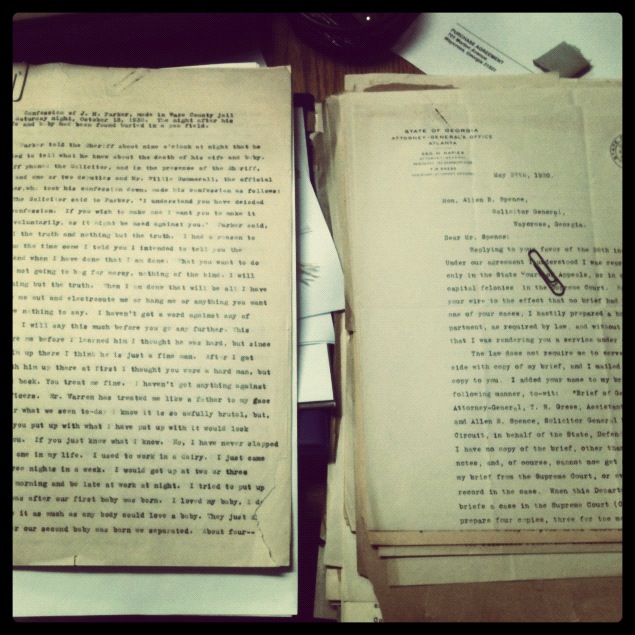
ONE LAST MIDNIGHT: A THESIS AND A DOUBLE MURDER
[flickr id=”13291918623″ thumbnail=”medium” overlay=”true” size=”original” group=”” align=”none”]
Tuesday night I watched True Detective for research. Yesterday I submitted the final draft of my thesis. Today I slept in. If I could say that in Latin, I would.
I post a lot about what I’m doing but rarely about what I’m writing, so I figured I would share a little about my thesis project, THE PEA PATCH MURDERS. My thesis is a kind of documentary project concerning a double murder in 1930 that happened outside of my home town in Georgia. A woman and her 18-month old daughter were found buried in a pea patch. Creepy, right? It’s only the beginning.
A man named James Parker was tried, convicted, and executed. The primary evidence for the conviction was based on the second-hand word of a fortune teller. There’s even a white painted horse, which, according to another document, was really a cow.
A lot of people have heard about this, but they don’t know much about it. Librarians have even tried to convince me that it’s a legend. That’s because all of the court documents were stored in the attic of a house that caught fire in 1940. In 1990, my father bought this house to use for his law practice. Stuffed away in the corner of the partially scorched attic was an old rusted footlocker filled with brittle tawny court records, testimonies, and affidavits.
All of the extant public literature on the case is essentially a facsimile of a 1938 article that reads incidentally extremely postmodern, fraught with fragmentation, paradox, alinearity, told by questionable and changing narrators.
[flickr id=”13292132424″ thumbnail=”medium” overlay=”true” size=”original” group=”” align=”none”]
My brother, who is a filmmaker, and I want eventually to write and make the film version of The Pea Patch Murders, and our discussions have greatly influenced how I wanted the thesis to function. The poetic iteration of The Pea Patch Murders consists of a chronological shuffling of various kinds of poems: poems that are strictly appropriated language from the articles and artifacts; poems that blend the appropriated language with my own; prose poems that are purely imaginative; audio transcriptions and homophonic translations; poems that are transcribed emails to me from friends and family members about the case; and poems that relate to the history only in concept or emotional register.
Other than the straight up weirdness surrounding the case, my initial obsessions were rooted in an interest in the function of language and its relationship to truth/fact/history, which are each distinct and yet part of the same. I encountered a strong sense of disorientation at the (mis)handling of facts, and this was exciting to me. This experience is at the core of the project, which allows the work to explore how ultimately, there is no sure certainty, and that the unreliability of language has a way of debunking our ontological and epistemological assumptions of truth and fact.
[flickr id=”13292131754″ thumbnail=”medium_640″ overlay=”true” size=”original” group=”” align=”none”]
It’s been fun working with Tony Trigilio, my thesis advisor, and talking about ideas for the project. I’ve watched a lot of documentaries for research. I’m especially interested in contemporary documentary films, which are often sensationalized and remixed in such a manner that the object of interest subtly shifts from the nominal subject of the documentary to the documentary itself. And I felt this gradual shift occurring in my thesis as well. What began about the unraveling of a family in 1930, slowly became more and more about my own family and my handling of the poems.
Next up: the movie version!
[flickr id=”13291838115″ thumbnail=”medium” overlay=”true” size=”original” group=”” align=”none”]
